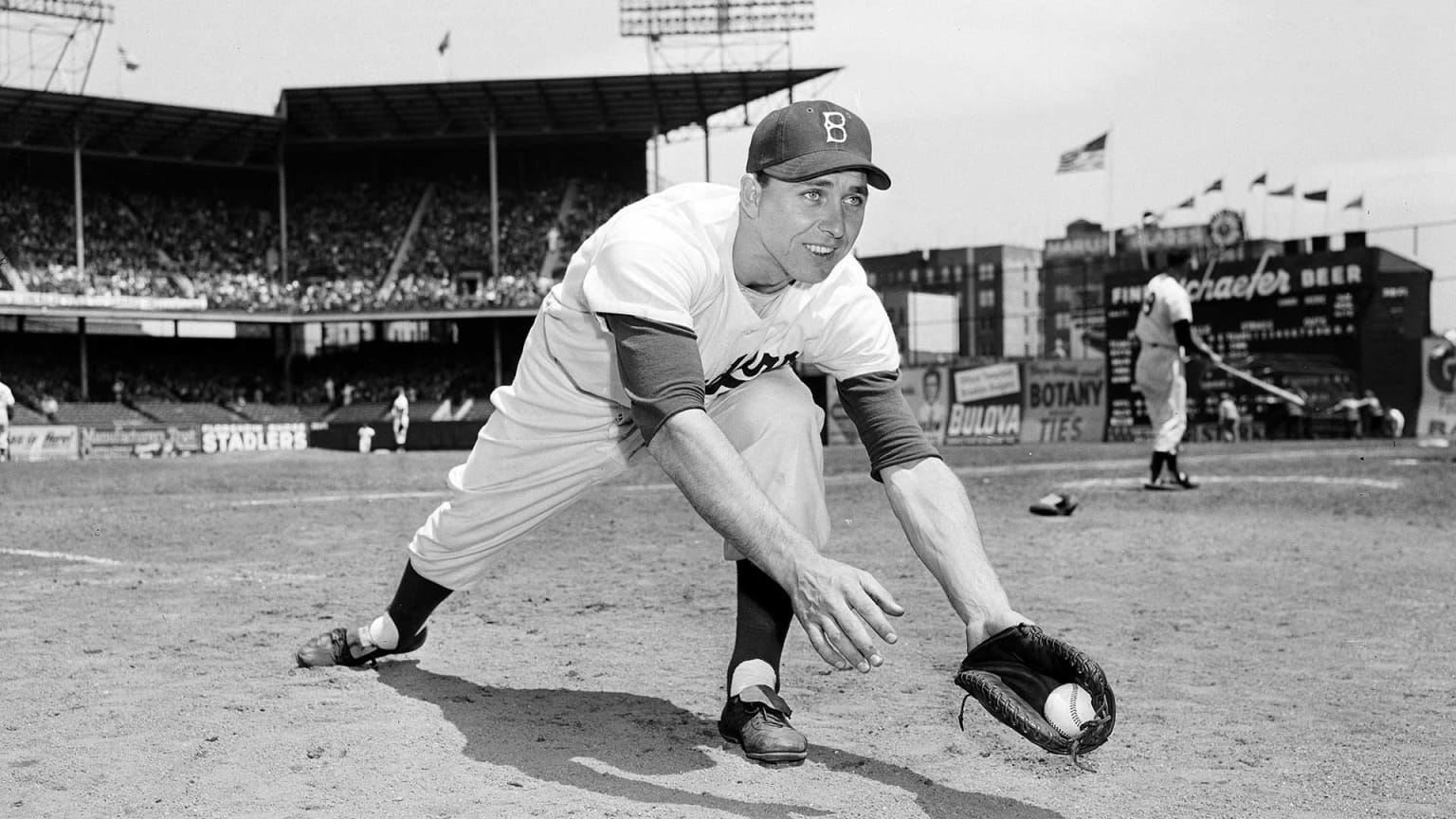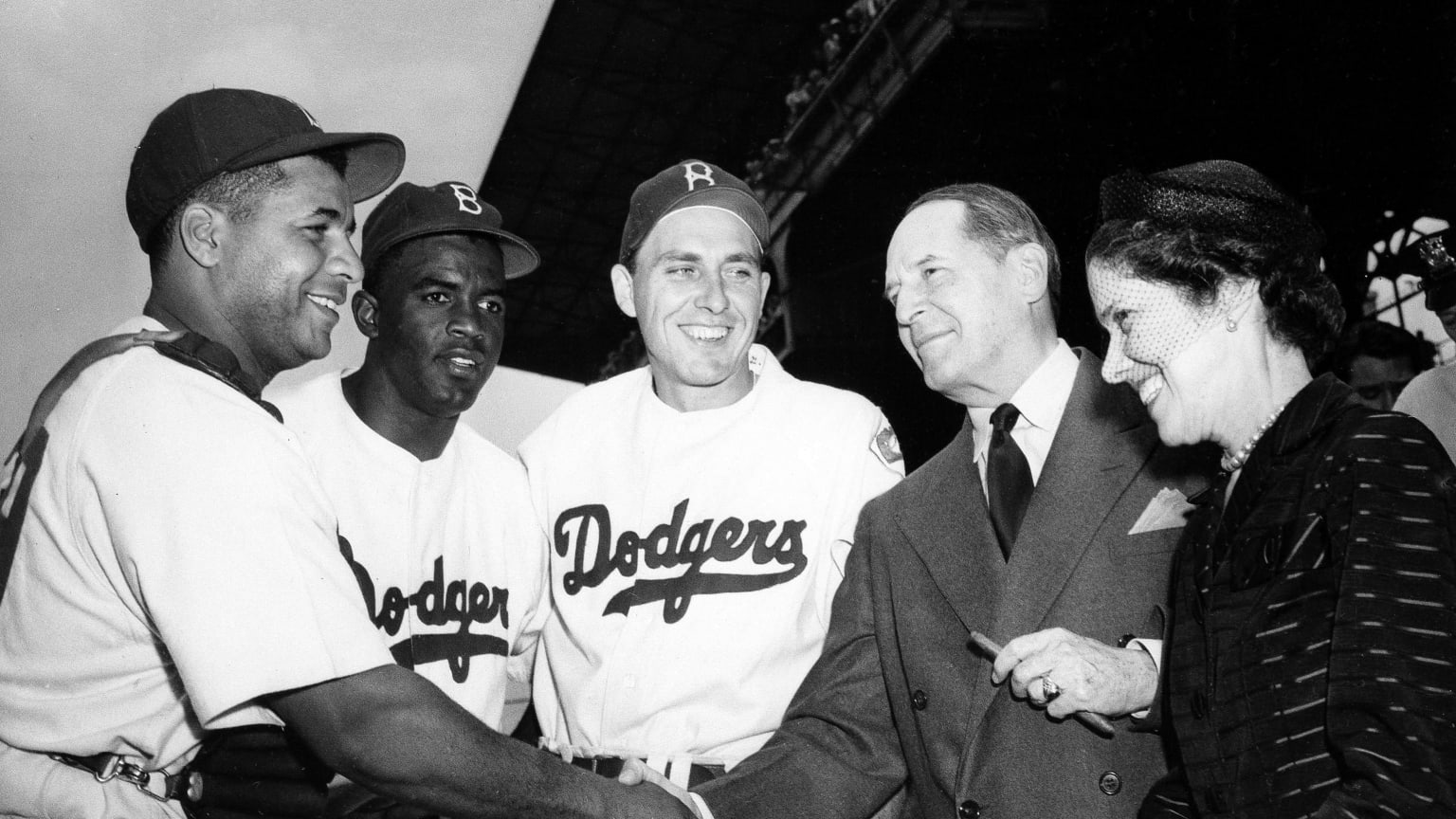Skip to comments.
Vin Scully: My thoughts on Gil Hodges
LA Dodgers' website ^
| November 29th, 2021
| Vin Scully
Posted on 12/01/2021 4:28:21 PM PST by Hebrews 11:6
Legendary Dodgers broadcaster Vin Scully penned the following essay on Gil Hodges, who is a candidate on the National Baseball Hall of Fame’s Golden Days Era Ballot. The 10-name Golden Days Era Committee ballot features candidates whose primary contribution to the game came from 1950-69. A 16-member committee is scheduled to meet on Sunday to discuss each candidate’s credentials for enshrinement, with any one candidate needing 12 votes to be elected to the Hall of Fame.
April 18, 1950. It was Opening Day and my first day working as a member of the Brooklyn Dodgers broadcast team. That afternoon, the Dodgers lost to the Phillies 9-1 at Shibe Park in Philadelphia. Playing first base that afternoon for the Dodgers was an imposing figure wearing number 14 -- Gil Hodges.
Over the next 12 seasons, I had the privilege of watching Gil every day as he consistently played a lead role on those Dodgers ballclubs. Whether it was his clutch hitting driving in runs, his defensive prowess at first base, or his quiet, yet effective, leadership on the field and in the clubhouse, Gil stood out as not only one of the game’s finest first basemen but also as a great American and an exemplary human being, someone who many of us were in awe of because of his spiritual strength. I often heard Dodgers players refer to Gil as a “saint.”
The son of an Indiana coal miner, Gil played one game for the Dodgers in 1943 at the age of 19 before enlisting in the U.S. Marines and serving our nation in World War II. He participated valiantly in the Pacific campaign, earning a Bronze Star for his actions during the Battle of Okinawa. He returned to the Dodgers in May 1947 and played an important role in one of the game’s most significant accomplishments -- the integration of Jackie Robinson into the Major Leagues.
Jackie dealt with relentless racial discrimination and unprovoked attacks from opposing teams and fans throughout his career. It was so painful to see for so long, and it would make you shudder. Gil was always there to protect Jackie as the unassuming, yet effective, peacekeeper on the field. While Jackie was the target of many on-the-field skirmishes, Gil was able to defuse many more of them. Their relationship was special. I remember a game when the Dodgers were playing the Cardinals in old Sportsman’s Park in St. Louis. There was a high foul ball by the first-base stands and Gil went over to make a play, and Jackie came over to back him up. Someone threw a whiskey bottle out of the upper deck in an attempt to hit Jackie. Thankfully, the bottle landed right between the two of them. I remember Gil patting Jackie on the back as if to say, “Hey, you’re not alone. I’m with you.”

Roy Campanella, Jackie Robinson and Gil Hodges of the Dodgers
meet General Douglas MacArthur in 1951. APGil’s support for Jackie and the Robinson family was not limited to just the playing field. The Hodges family supported the Robinsons and did whatever was needed to help them during difficult times, including grocery shopping for the Robinson family while the Dodgers were in Florida for Spring Training at a time in the South when, sadly, African Americans were not allowed to shop in many of the nearby markets. Everything Gil did for Jackie and his family was done quietly and without any fanfare or attention drawn to himself. At Gil’s funeral in 1972, a sobbing Jackie told Gil’s son Gil Jr., “Next to my son’s death, this is the worst day of my life.”
I was thrilled to recently learn that Gil, once again, is on the ballot for the Baseball Hall of Fame as a nominee on the Golden Days Era committee, which votes on Dec. 5.
While statistics, records, and awards are used as the primary measurements of success for determining those elected, the Hall’s voting criteria also includes consideration for the “integrity, sportsmanship, and character” of each nominee. When one combines Gil’s impressive and consistent play on the field, his innovative managerial approach and leadership of the New York Mets culminating in the greatest upset in baseball history in 1969, and his unwavering commitments to his faith, family, country, and social justice, you have the rare instance of the ideal candidate. Hall of Fame voters have long used the “integrity, sportsmanship, and character” clause to exclude nominees for a host of committed transgressions. It seems only logical for voters to use that same clause in the affirmative to consider nominees who embodied those positive virtues.
I am often asked who the best ballplayer was that I watched during my broadcasting career. In looking back over my 67 years behind the microphone, I was truly blessed to watch firsthand so many of the all-time greats performing at their very best on the biggest stages in the game’s history. It is truly impossible for me to single out just one player. However, in terms of the players I watched who performed at a high level on the playing field, but at an even higher level off the field in how they lived and carried out their lives, my response is an easy one -- Gil Hodges.
(Vin Scully appears in a new documentary film on Gil Hodges titled, “Soul of a Champion: The Gil Hodges Story.” The 30-minute film can be streamed for free at www.gilhodgesfilm.com)
TOPICS: History; Religion; Sports
KEYWORDS: brooklyndodgers; dodgers; gilhodges; losangelesdodgers; vinscully
Navigation: use the links below to view more comments.
first 1-20, 21-40 next last
When the Dodgers moved to Los Angeles in 1958, the Hodges family settled in a house two blocks from me in east Long Beach. Been a fan ever since.
To: Hebrews 11:6
That’s cool.
Where’s east Long Beach?
2
posted on
12/01/2021 4:39:34 PM PST
by
ifinnegan
(Democrats kill babies and harvest their organs to sell)
To: Hebrews 11:6
I grew up in L.A. in the 1950s, and I remember the Dodgers coming to L.A. from N.Y. I saw a few Dodgers games when they played at the Coliseum (for old guys like me, do you remember the high left field screen/fence?). Those were great times: Gil Hodges; Sandy Koufax; Duke Snider; Don Demeter; Wally Moon; Ron Fairly; Charlie Neal; just to name a few.
3
posted on
12/01/2021 4:41:44 PM PST
by
ought-six
(Multiculturalism is national suicide, and political correctness is the cyanide capsule. )
To: Hebrews 11:6
Interesting story. Thanks for posting. 🙂
To: Hebrews 11:6
He hit four home runs in a single game in 1950.
5
posted on
12/01/2021 4:46:05 PM PST
by
ComputerGuy
(Heavily-medicated for your protection)
To: ifinnegan
Carson St. @ Woodruff Av., 25 miles SE of downtown LA.
6
posted on
12/01/2021 4:46:06 PM PST
by
Hebrews 11:6
(Watch "THE CHOSEN," about Jesus & the disciples He chose: https://watch.angelstudios.com/thechosen)
To: Hebrews 11:6
The Dodgers manager was taking a great risk letting his players meet with General MacArthur. Could lead to insubordination.
To: ought-six
257’ down the left-field line, 440’ to right-center. The first time Willie Mays saw that, he exclaimed, “What did they do to you, Duke?”
8
posted on
12/01/2021 4:49:53 PM PST
by
Hebrews 11:6
(Watch "THE CHOSEN," about Jesus & the disciples He chose: https://watch.angelstudios.com/thechosen)
To: ComputerGuy
The only Dodger to do so until Shawn Green.
9
posted on
12/01/2021 4:51:10 PM PST
by
Hebrews 11:6
(Watch "THE CHOSEN," about Jesus & the disciples He chose: https://watch.angelstudios.com/thechosen)
To: nickcarraway
Old Dodgers never die, they....
10
posted on
12/01/2021 4:52:24 PM PST
by
Hebrews 11:6
(Watch "THE CHOSEN," about Jesus & the disciples He chose: https://watch.angelstudios.com/thechosen)
To: Hebrews 11:6
Thanks. Near the great LGB airport. I didn’t know people referred to east Long Beach.
11
posted on
12/01/2021 5:08:47 PM PST
by
ifinnegan
(Democrats kill babies and harvest their organs to sell)
To: ifinnegan
Back in the day it was called Belmont Heights. It’s where I grew up. Corner lot at 3rd, and Euclid. A quiet residential area just above Belmont Shore. Lots of memories. Schools were Fremont Elementary, Jefferson Jr. High, and Wilson High. Then the Army.
12
posted on
12/01/2021 5:16:02 PM PST
by
rockinqsranch
(Dems, Libs, Socialists Call 'em what you will, they all have fairies livin' in their trees)
To: Hebrews 11:6
April 18, 1950, I was just shy of two years old. Look at the scoreboard behind Gil in that photo. Schaefer Beer. Holy cow. Never knew he served as a Marine in WW II.
13
posted on
12/01/2021 5:20:26 PM PST
by
4Runner
To: 4Runner
No one messed with Gil Hodges.
14
posted on
12/01/2021 5:30:22 PM PST
by
Hebrews 11:6
(Watch "THE CHOSEN," about Jesus & the disciples He chose: https://watch.angelstudios.com/thechosen)
To: ought-six
Loved my Brooklyn Dodgers.
Always wanted to be on Happy Felton’s Knothole Gang...never got there.
Once they moved, they were dead to me.
As long as I cared about baseball, I never rooted for that team from LA.
15
posted on
12/01/2021 5:34:12 PM PST
by
Roccus
(Prima di ogni altra cosa, siati armati!)
To: 4Runner
The “h” and the first “e” in Schaefer lit up to signal hit or error. Look close and you can see the light tubes, especially in the “h”.
There was a box on the roof behind home plate for (I believe) the PA announcer. It also had a hit/error indicator.
16
posted on
12/01/2021 5:43:19 PM PST
by
Roccus
(Prima di ogni altra cosa, siati armati!)
To: Hebrews 11:6
Carson St. @ Woodruff Av., 25 miles SE of downtown LA.
My mother worked at the Vons store on that corner from 1966 to 1986.
To: ifinnegan
Where’s east Long Beach?Who's Gil Hodges?
To: chrisinoc
That was our store. I walked past it twice daily going to Lakewood High, ‘63-’66.
19
posted on
12/01/2021 6:05:12 PM PST
by
Hebrews 11:6
(Watch "THE CHOSEN," about Jesus & the disciples He chose: https://watch.angelstudios.com/thechosen)
To: Hebrews 11:6
Evidently he once had been looking at a home in my little town in NJ, but passed it up. I rarely go by that house without thinking of him.
20
posted on
12/01/2021 6:11:29 PM PST
by
Exit148
(I’m)
Navigation: use the links below to view more comments.
first 1-20, 21-40 next last
Disclaimer:
Opinions posted on Free Republic are those of the individual
posters and do not necessarily represent the opinion of Free Republic or its
management. All materials posted herein are protected by copyright law and the
exemption for fair use of copyrighted works.
FreeRepublic.com is powered by software copyright 2000-2008 John Robinson

